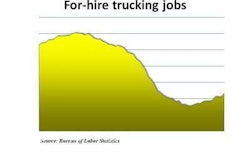The public comment period ended Friday, March 4, for the Federal Motor Carrier Safety Administration’s proposed rulemaking on hours-of-service requirements for commercial vehicle drivers. FMCSA, which is proposing seven changes from the rules in place today, originally planned the 60-day comment period to expire Monday, Feb. 28, but later announced an extension.
The NPRM would:
• Limit drivers to either 10 or 11 hours of driving time – to be determined during the rulemaking process – following a period of at least 10 consecutive hours off duty. (FMCSA currently favors reducing driving to 10 hours);
• Limit the standard ‘‘driving window’’ to 14 hours, while allowing that number to be extended to 16 hours twice a week;
• Limit actual duty time within the driving window to 13 hours;
• Permit drivers to drive only if 7 hours or less have passed since their last off-duty or sleeper-berth period of at least 30 minutes;
• Retain the 34-hour restart, subject to certain limits: The restart would have to include two periods between midnight and 6 a.m. and could be started no sooner than 168 hours (7 days) after the beginning of the previously designated restart;
• Redefine ‘‘on duty’’ to allow some time spent in or on the CMV to be logged as off duty; and
• Revise the oilfield operations exception to clarify the language on waiting time and to state that waiting time would not be included in the calculation of the driving window.
A bipartisan group of congressmen and senators last week called on the Obama administration to abandon the hours-of-service proposal and retain the current safety rules. “The rules currently in place are working well and do not need to be changed,” 122 representatives wrote to U.S. Transportation Secretary Ray LaHood. “Since the current rules were implemented seven years ago, the trucking industry’s safety performance has improved at an unprecedented rate.”
The letter notes that since those rules went into effect in 2004, the number of fatal and injury crashes involving large trucks have fallen to historic lows, even as trucks hauling the nation’s food, fuel, medicine and other goods have driven almost 10 billion more miles. “If the proposed changes are put in place, companies will be forced to increase the number of trucks on the road necessary for delivering the same amount of freight, adding to final product costs and increasing congestion on our nation’s highways,” a group of 23 senators wrote in their letter to LaHood.
Lawmakers added that the proposed rules are much more opaque and complex than the current standards, and that “such complexity will only serve to hamper both industry compliance and motor carrier enforcement.”
“It is increasingly clear that this proposal is the result of political pressure and not a fair interpretation of trucking’s safety record,” says Bill Graves, American Trucking Associations president and chief executive officer. “ATA appreciates that some politicians are basing their views not on politics, but on the hard evidence that the current hours-of-service rules are working.”
ATA last month released an independent review of the Federal Motor Carrier Safety Administration’s hours-of-service Regulatory Impact Analysis that found the agency overstated the proposal’s benefits. The Edgeworth Economics review argued that while FMCSA states its proposal would result in up to $380 million in annual benefits, the proposal actually would result in net costs, and not benefits, of about $320 million a year. According to the study, FMCSA made unreasonable assumptions about the safety of the trucking industry by sampling only carriers it subjected to a compliance review, generally for not following federal safety rules; and in formulating its proposal, FMCSA used crash data collected before the current rules went into effect, ignoring their positive safety impact on the industry.
Last week, a researcher who worked on the scientific studies that FMCSA used to support its proposed changes to the current hours-of-service rules says the agency misapplied those studies’ findings. Just before a listening session last month concerning its hours-of-service proposal, FMCSA placed three additional documents in the public docket concerning the cumulative fatigue function, coefficient estimates and an explanation of coefficient names as requested by ATA; and an Excel spreadsheet containing data using the formula in the HOS Regulatory Evaluation to link the hours worked in the previous week to fatigue the following week. The agency also made a number of clerical corrections to the HOS proposed rule.













